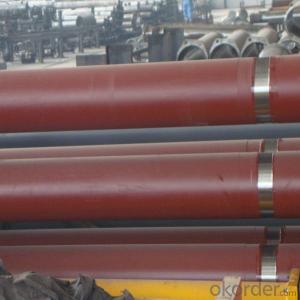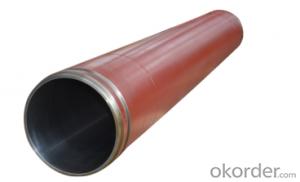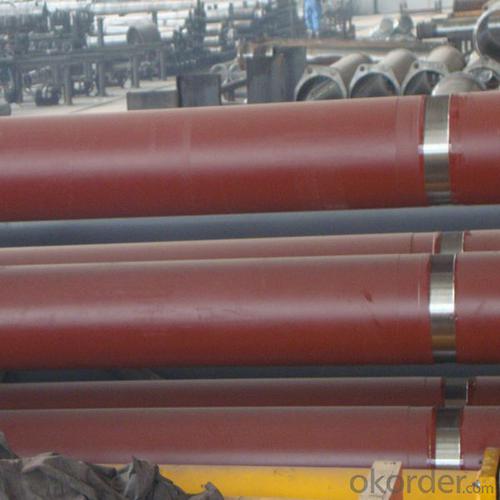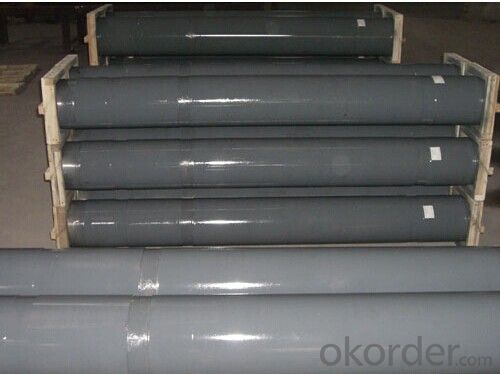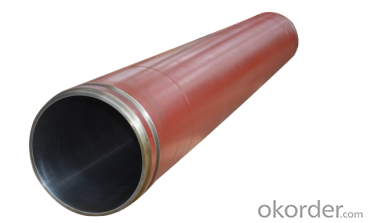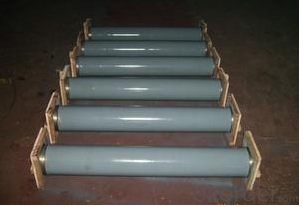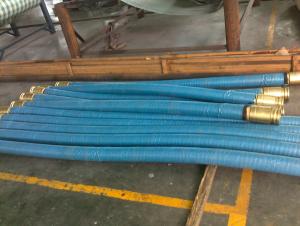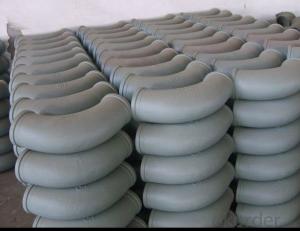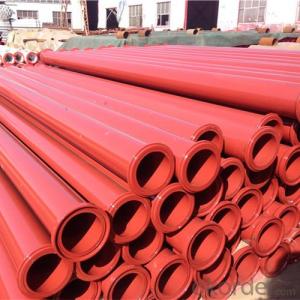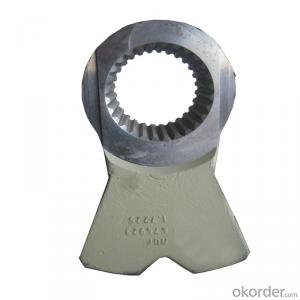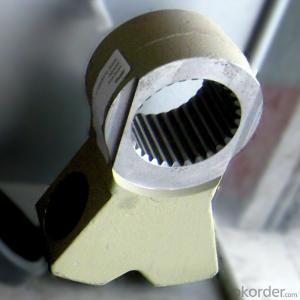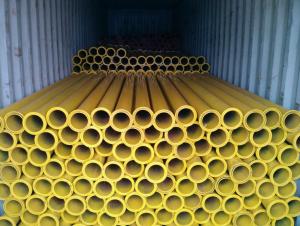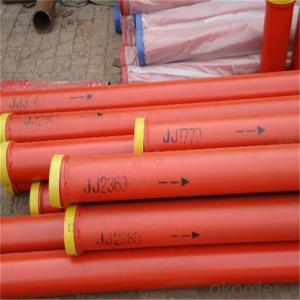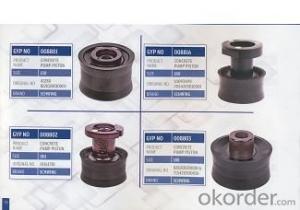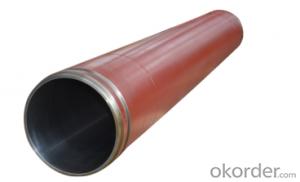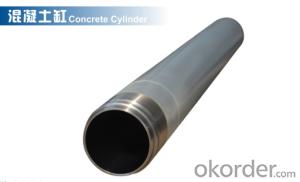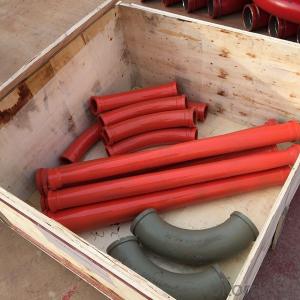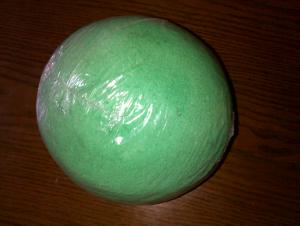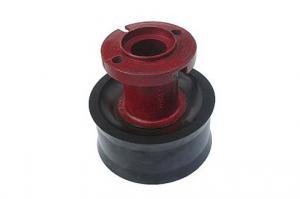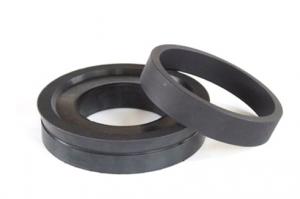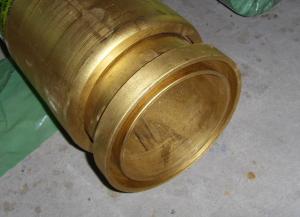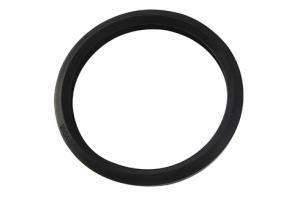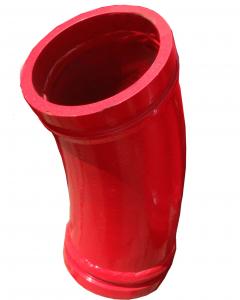Concrete Pump Delivery Cylinder DN200*1775(SCHWING)
- Loading Port:
- Shanghai
- Payment Terms:
- TT OR LC
- Min Order Qty:
- 2 pc
- Supply Capability:
- 1000 pc/month
OKorder Service Pledge
OKorder Financial Service
You Might Also Like
Product Description:
The Concrete Pump Delivery Cylinder DN200*1775(SCHWING) usually made by steel material No. C45. by Chinese standard according to customer’s requests as well, and it will be packed in bundles or nude packing directly put into container.Most of customers likes to buy it together with delivery pipes and elbows.
Scope of Application of the Cylinders
The Concrete Pump Delivery Cylinder DN200*1775(SCHWING) is a concrete pumping parts for combined use with other concrete pumps parts in concrete pumping operations. It can be widely used on Schwing stationary pump, Schwing truck pumps as well.
This Concrete Pump Delivery Cylinder DN200*1775(SCHWING) can only be used in Schwing concrete pump construction operations, but not in any other operations, like dragging, moving, or hoisting heavy articles or personnel. The pipe is also not allowed to be used in any location where any combustible or explosive material exists or a cave-in may occur.
Specifications:
Concrete Pump Delivery Cylinder DN200*1775
1. Capacity: 60,000~80,000cbm
2. Size: DN180, DN200, DN230..
4. Brand: SCHWING
5. Material: C45
6. Quenching and tempering to improve the hardness to HB241-280
7. Inner wall chrome thickness is 0.25-0.30mm, hardness HV820-900.
Product Advantages:
OKorder's Cylinders DN200*1775 Channels are durable, strong, and safety.
Main Product Features:
· Premium quality
· Prompt delivery & seaworthy packing (10-20 days)
Reliable performance
Easy to weld
High safety.
· Professional Service
· Competitive pricing
Measuring of wall thickness from the outside
Low purchase cost
FAQ:
Q1: How long about delivery time about DN200*1775?
A1: Normally we keep the raw materials for old customers and sometime we also keep stock products to make sure delivery time in any emergency cases.
Q2: How do we guarantee the quality of our Cylinders DN200*1775?
A2: We have established an advanced quality management system which conducts strict quality tests at every step, from raw materials to the final product. At the same time, we provide extensive follow-up service assurances as required.
Q3: How soon can we receive the product after purchase?
A3: Within three days of placing an order, we will book the vessel for goods. The specific shipping date is dependent upon international and government factors, but is typically10 to 30 workdays.
Q4: If we can produce some Cylinders DN200*1775 according to customers request?
A4: Yes, we can produce Cylinders DN200*1775 according to the difference country situations to make it suitable to the market and customers. We have very professional technical team to make the design.
Q5: How to make a quick resolution for after service?
A5: OKorder and our manufacture both have overseas branches all-around of world, If needed,
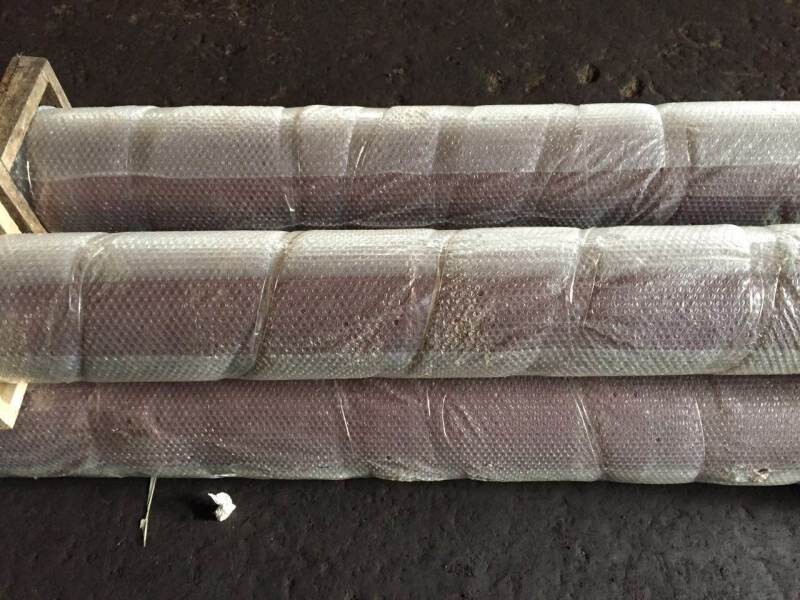
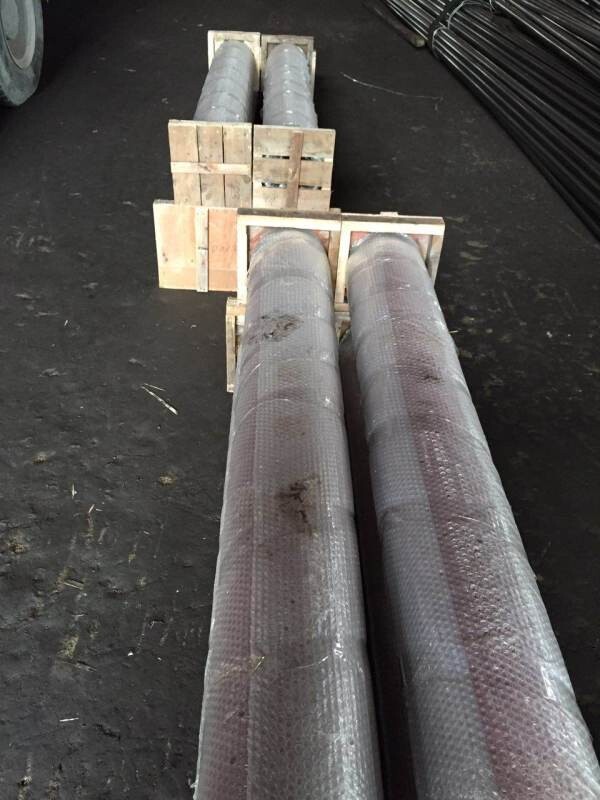
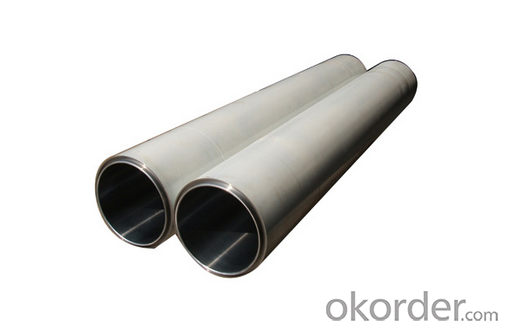
- Q: What kind of concrete pump truck?
- But the drawback is that the delivery speed is slow. Delivery height is better than vehicular pump. Among them, the more moderate is the car pump. But the advantage is that the arm pump can do, it can do, that is, when construction, need to install the pump ahead of time, relatively troublesome. But the relative pump speed and delivery height are higher
- Q: Are there any specific guidelines for the installation of sensors or transmitters in concrete pump spare parts?
- Yes, there are specific guidelines for the installation of sensors or transmitters in concrete pump spare parts. These guidelines are important to ensure the proper functioning and accurate readings of the sensors or transmitters. Firstly, it is crucial to carefully select the location for installing the sensors or transmitters. The chosen location should allow for easy access and maintenance, while also ensuring that the sensors or transmitters are not exposed to excessive vibration, moisture, or extreme temperatures. Secondly, it is recommended to use appropriate mounting hardware for securing the sensors or transmitters to the concrete pump spare parts. This hardware should be able to withstand the operating conditions and any potential vibrations or shocks that may occur during the pumping process. Additionally, it is important to follow the manufacturer's instructions for wiring and connection of the sensors or transmitters. Proper wiring and connection are essential to ensure accurate and reliable data transmission. Furthermore, regular inspections and maintenance should be conducted to ensure that the sensors or transmitters are functioning correctly. This includes checking for any loose connections, signs of wear or damage, and ensuring that the sensors or transmitters are calibrated properly. Overall, following these specific guidelines for the installation of sensors or transmitters in concrete pump spare parts can help to ensure their optimal performance and longevity, ultimately enhancing the efficiency and safety of the concrete pumping operation.
- Q: What are the indications of a faulty control lever?
- Some indications of a faulty control lever may include difficulty in shifting gears, a loose or wobbly lever, or the lever not returning to its original position after being released. Other signs could be grinding or crunching noises when engaging the lever, or if the lever feels sticky or unresponsive.
- Q: What are the different types of concrete pump pistons?
- There are several different types of concrete pump pistons that are commonly used in the construction industry. These include: 1. Single-acting pistons: These pistons have one working side and are used in smaller concrete pumps. They push the concrete out of the cylinder during the forward stroke and rely on gravity to pull the piston back during the return stroke. 2. Double-acting pistons: These pistons have two working sides and are used in larger concrete pumps. They push the concrete out during the forward stroke and pull it back during the return stroke, increasing the efficiency of the pumping process. 3. S-tube pistons: These pistons are shaped like an S and are commonly used in trailer-mounted concrete pumps. They help to control the flow of concrete by directing it through a series of valves and pipes. 4. Rock valve pistons: These pistons are designed specifically for pumping concrete with larger aggregates. They have a rugged design that can handle the more abrasive nature of these types of materials. 5. Gate valve pistons: These pistons use a gate valve system to control the flow of concrete. They are commonly used in high-pressure applications and offer precise control over the amount of concrete being pumped. Overall, the type of concrete pump piston used will depend on the specific requirements of the construction project, including the size of the pump, the type of concrete being pumped, and the desired flow rate and pressure.
- Q: What is the purpose of a concrete pump wear plate?
- The purpose of a concrete pump wear plate is to protect the pumping system from wear and tear caused by the abrasive nature of concrete. Concrete pumps are used to transfer concrete from the mixer to the construction site, and during this process, the concrete passes through the wear plate. It acts as a barrier between the pumping system and the abrasive concrete, preventing direct contact and reducing the damage caused by the constant flow of concrete. The wear plate is typically made of durable materials such as hardened steel or tungsten carbide, which are resistant to the abrasive forces exerted by the concrete. By having a wear plate in place, the lifespan of the pumping system is significantly extended, reducing the need for frequent repairs and replacements. Overall, the purpose of a concrete pump wear plate is to ensure the efficient and reliable operation of concrete pumps by protecting and preserving the integrity of the pumping system.
- Q: How long does a concrete pump piston typically last?
- The duration of a concrete pump piston's life can differ based on various factors. Typically, a concrete pump piston will endure approximately 20,000 to 40,000 cubic yards of pumping. However, this approximation can be influenced by multiple aspects, including the concrete's quality, pump maintenance and care, operating conditions, and operator expertise. Consistent maintenance and servicing, which encompass cleaning and lubricating the piston, can considerably lengthen its lifespan. It is crucial to regularly assess the wear and tear of the piston to guarantee its optimal performance and replace it as needed.
- Q: How do I ensure the compatibility of mechanical components in concrete pump spare parts?
- To ensure the compatibility of mechanical components in concrete pump spare parts, it is crucial to consider several factors. First, it is important to identify the specific make and model of the concrete pump and its components. This information will help in sourcing the correct spare parts that are designed to fit and function properly with the existing system. Additionally, it is recommended to consult the manufacturer's documentation or reach out to their customer support for guidance. They can provide detailed specifications and compatibility guidelines for the mechanical components. It is essential to match the dimensions, tolerances, and materials of the spare parts to the original components to ensure a proper fit and optimal performance. Furthermore, working with reputable suppliers or distributors who specialize in concrete pump spare parts can greatly enhance compatibility assurance. These professionals have extensive knowledge and experience in the industry and can guide you in selecting the right components that are compatible with your specific concrete pump model. Regular maintenance and inspection of the mechanical components are also essential to identify any wear or damage. By addressing any issues promptly and replacing worn-out parts with compatible ones, you can ensure the overall compatibility and longevity of the mechanical components in your concrete pump spare parts.
- Q: How can one identify the correct thread size and type for concrete pump spare parts?
- To identify the correct thread size and type for concrete pump spare parts, there are a few steps one can follow: 1. Refer to the equipment manual: The first step is to consult the manual or documentation that came with the concrete pump. It often contains detailed information about the thread sizes and types used for different parts. 2. Measure the existing part: If the manual is not available or does not provide the necessary information, one can take measurements of the existing part. Use a caliper or a thread gauge to measure the diameter and pitch of the thread. This will help determine the correct size and type needed for replacement. 3. Seek assistance from the manufacturer: If the manual or measurements do not provide satisfactory results, it is advisable to reach out to the manufacturer or supplier of the concrete pump. They have expert knowledge about the specific thread sizes and types used in their equipment and can guide you in finding the correct spare parts. 4. Consult industry standards: Depending on the region and type of concrete pump, there may be industry standards or norms that dictate the thread sizes and types used in these machines. Researching and referencing these standards can provide valuable insights into the correct specifications for spare parts. 5. Engage with experienced professionals: Another effective way to identify the correct thread size and type is to seek advice from experienced professionals in the concrete pumping industry. They may have encountered similar situations and can provide guidance based on their expertise. Overall, a combination of consulting equipment manuals, measuring existing parts, contacting the manufacturer, studying industry standards, and seeking advice from professionals can help in identifying the correct thread size and type for concrete pump spare parts.
- Q: How can a damaged concrete pump piston affect the pumping efficiency?
- A damaged concrete pump piston can significantly affect the pumping efficiency in various ways. Firstly, a damaged piston can lead to decreased power and force exerted by the pump, resulting in reduced pumping capacity. The piston is responsible for creating the necessary pressure to push the concrete mixture through the pumping system. If it is damaged, it may not be able to generate sufficient pressure, leading to slower and less efficient pumping. Secondly, a damaged piston can cause leaks within the pump system. The piston is a critical component that seals the concrete and prevents it from leaking back into the hopper. If it is damaged or worn out, it may not create a tight seal, resulting in leakage. This not only leads to a loss of material but also reduces the efficiency of the pumping process as the pump has to work harder to compensate for the loss. Furthermore, a damaged piston can also cause blockages and clogs in the pumping system. The piston's movement creates suction, which pulls the concrete mixture into the pump. If the piston is damaged, it may not create enough suction, causing the mixture to flow unevenly or get stuck in the system. This can cause delays and interruptions in the pumping process, reducing overall efficiency. In conclusion, a damaged concrete pump piston can impact pumping efficiency by reducing power and force, causing leaks, and leading to blockages. Regular maintenance and timely repair or replacement of damaged pistons are essential to ensure optimal pumping performance and efficiency.
- Q: How do I properly adjust and control flow rates in concrete pump spare parts?
- In order to achieve proper adjustment and control of flow rates in concrete pump spare parts, it is important to follow a series of key steps: 1. Get acquainted with the equipment: Take the time to familiarize yourself with the specific concrete pump spare parts you will be working with. Read the user manual and review any documentation provided by the manufacturer. This will give you a comprehensive understanding of the equipment's capabilities and effective methods for adjusting flow rates. 2. Verify the pump settings: Prior to commencing any concrete pumping operation, ensure that the pump settings are correctly configured. This involves checking the hydraulic pressure, engine RPM, and any other relevant settings. Confirm that all valves and controls are in the appropriate position for the desired flow rate. 3. Monitor the pump speed: The speed of the pump directly influences the flow rate of the concrete. Different concrete mixtures may require varying pump speeds in order to achieve the desired flow rate. Adjust the engine RPM accordingly, referring to the manufacturer's recommendations and any specific project requirements. 4. Modify the pump stroke: Many concrete pumps offer adjustable pump strokes to regulate the flow rate. By altering the length of the stroke, you can increase or decrease the volume of concrete being pumped. Experiment with different stroke lengths to determine the optimum flow rate for your particular application. 5. Utilize the control panel: Numerous concrete pumps are equipped with a control panel that allows for precise adjustment of flow rates. Make use of these features to fine-tune the flow rate. Use the control panel to monitor the pump's performance and make any necessary adjustments to maintain a consistent flow. 6. Regularly inspect and maintain the equipment: Proper maintenance is essential to ensure accurate adjustment and control of flow rates. Routinely inspect the concrete pump spare parts for any signs of wear or damage. Clean and lubricate the components as recommended by the manufacturer. A well-maintained pump will operate more efficiently and provide more precise control over flow rates. By adhering to these steps, one can effectively adjust and control flow rates in concrete pump spare parts. Always prioritize safety and consult the manufacturer's instructions and guidelines for specific recommendations and considerations.
Send your message to us
Concrete Pump Delivery Cylinder DN200*1775(SCHWING)
- Loading Port:
- Shanghai
- Payment Terms:
- TT OR LC
- Min Order Qty:
- 2 pc
- Supply Capability:
- 1000 pc/month
OKorder Service Pledge
OKorder Financial Service
Similar products
Hot products
Hot Searches
Related keywords
